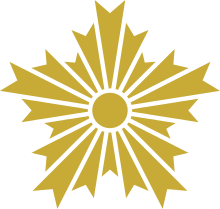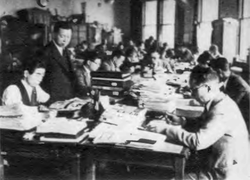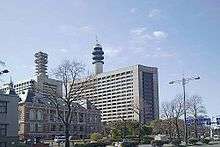Tokyo Metropolitan Police Department
The Tokyo Metropolitan Police Department (警視庁, Keishichō) serves as the prefectural police department of Tokyo Metropolis. Founded in 1874, it is headed by a Superintendent-General, who is appointed by the National Public Safety Commission, and approved by the Prime Minister.
| Tokyo Metropolitan Police Department 警視庁 Keishichō | |
|---|---|
 Asahikage | |
 Headquarters building | |
| Agency overview | |
| Formed | 1874 |
| Jurisdictional structure | |
| National agency (Operations jurisdiction) | Japan |
| Operations jurisdiction | Japan |
| Legal jurisdiction | Tokyo |
| Governing body | Tokyo Metropolitan Government |
| Operational structure | |
| Overviewed by Commission | Tokyo Metropolitan Public Safety Commission |
| Headquarters | 1-1 Kasumigaseki 2-chome, Chiyoda-ku, Tokyo 100-8929 |
| Officers | 43,505 |
| Police Administrative Civilians | 2,961 |
| Agency executives |
|
| Bureaus | 6
|
| Facilities | |
| Stations | 102 |
| Patrol Cars | 1292 |
| Police Motorcycles | 960 |
| Boats | 22 |
| Helicopters | 14 |
| Police Dogs | 37 |
| Police Horses | 16 |
| Website | |
| Tokyo Metropolitan Police Department (in Japanese) Tokyo Metropolitan Police Department (in English) | |
.png)

The Metropolitan Police, with a staff of more than 40,000 police officers, and over 2,800 civilian personnel, manages 102 stations in the prefecture.[1]
The main building of the Tokyo Metropolitan Police Department is located in the Kasumigaseki, Chiyoda ward, Tokyo. Built in 1980, it is 18 stories tall, a large wedge-shaped building with a cylindrical tower. It is easily seen from the street and a well-known landmark.
The HQ building is located in Sakurada Gate, so it is also called "Sakurada Gate".[2]
History
To prepare for the G20 summit in 2019, the TMPD announced the establishment of the Water Response Team in order to police bodies of water near G20 summit venues.[3]
Scandals
In 1978, the TMPD was investigated when a uniformed officer killed a female university student inside her residence.[4] In 1997, an officer was caught for making up information in an amphetamine case.[4]
In 2007, the TMPD was under scrutiny when a serving TMPD officer was involved in an incident where he used his official sidearm to shoot a female person to death before he committed suicide.[4] The TMPD was investigating an incident in the Kamata Police Station in Ota Ward where a police officer committed suicide in February 2014 due to harassment at work. The chief in charge was disciplined.[5]
Organization
The Metropolitan Police Department is under the command of a Superintendent-General and reports directly to the Tokyo Metropolitan Public Safety Commission. The Superintendent-General can be appointed and replaced at any time as long as the prime minister and the TMPSC receives their approval.[6]
Since the MPD is autonomous, it does not operate under the authority of any Regional Police Bureau.[7]
The MPD commands the following bureaus:[1]
- Administration Bureau (総務部)
- Personnel and Training Bureau (警務部)
- Traffic Bureau (交通部)
- Community Police Affairs Bureau (地域部)
- Security Bureau (警備部)
- Public Security Bureau (公安部)
- Criminal Investigation Bureau (刑事部)
- Community Safety Bureau (生活安全部)
- Organized Crime Control Bureau (組織犯罪対策部)
The MPD also has its own academy, the Metropolitan Police Department Academy.
Ranks and insignia
The ranks used in the TMPD have been slightly revised in 2013, changing only the English translation of some of the ranks used by the force.[1]
Otherwise, these ranks are observed throughout its history.[8]
- Superintendent-General (four gold rising suns)
- Deputy Superintendent-General (not rank, but post of MPD. gold-wreathed gold emblem with three gold bars)[lower-alpha 1]
- Senior Commissioner (gold-wreathed gold emblem with three gold bars), formerly Superintendent Supervisor[lower-alpha 2]
- Commissioner (gold-wreathed gold emblem with two gold bars), formerly Chief Superintendent[lower-alpha 3]
- Assistant Commissioner (gold-wreathed gold emblem with one gold bar), formerly Senior Superintendent[lower-alpha 4]
- Superintendent (gold-wreathed silver emblem with three gold bars)
- Chief Inspector (gold-wreathed silver emblem with two gold bars), formerly Inspector[lower-alpha 5]
- Inspector (gold-wreathed silver emblem with one gold bar), formerly Assistant Inspector[lower-alpha 6]
- Sergeant (silver-wreathed silver emblem with three gold bars)
- Senior Police Officer (silver-wreathed silver emblem with two gold bars)
- Police Officer (silver-wreathed silver emblem with one gold bar)
Gallery
 Metropolitan Police HQ
Metropolitan Police HQ- Metropolitan Police HQ seen from the Tokyo Imperial Palace


 Hayabusa helicopter (AgustaWestland AW109E, JA34MP)
Hayabusa helicopter (AgustaWestland AW109E, JA34MP) Uniformed officer
Uniformed officer
See also
Notes
- Not observed from TMPD websites/books as of 2018.
- Minor adaptions were made by the TMPD in 2013.
- Minor adaptions were made by the TMPD in 2013.
- Minor adaptions were made by the TMPD in 2013.
- Minor adaptions were made by the TMPD in 2013.
- Minor adaptions were made by the TMPD in 2013.
References
- "Wayback Machine" (PDF). web.archive.org. 17 November 2017. Archived from the original (PDF) on 2017-11-17.
- 霞が関、桜田門、兜町…「別の意味」でも使われる東京の地名 - Money post web(01/14/2020)
- "東京五輪警備へ初の対テロ部隊 警視庁". Sankei Shimbun (in Japanese). 13 May 2019.
- "Top Tokyo cop reprimanded for alleged murder by officer". The Japan Times. Kyodo News. 21 September 2007.
- Clegg, Cara (23 April 2014). "'Power harrassment' [sic] in Japan's police force blamed for officer's suicide". SoraNews24.
- "The Present Police Organizations of Japan and the Philippines" (PDF). Retrieved 2019-05-13.
- Nakahara, Hidenori (1956). "The Japanese Police" (PDF). scholarlycommons.law.northwestern.edu. Retrieved 2019-05-13.
- "The Police of Japan" (PDF). National Police Agency of Japan. 1982. Retrieved 2019-05-13 – via National Criminal Justice Reference Service.
- Metropolitan Police Department, police stations Archived 2014-08-03 at the Wayback Machine, Ogasawara Archived 2014-10-02 at the Wayback Machine: 管内の概況 Archived 2014-08-09 at the Wayback Machine
External links
| Wikimedia Commons has media related to Metropolitan Police Department (Tokyo). |
- Tokyo Metropolitan Police Department (in Japanese)
- Tokyo Metropolitan Police Department (in English)